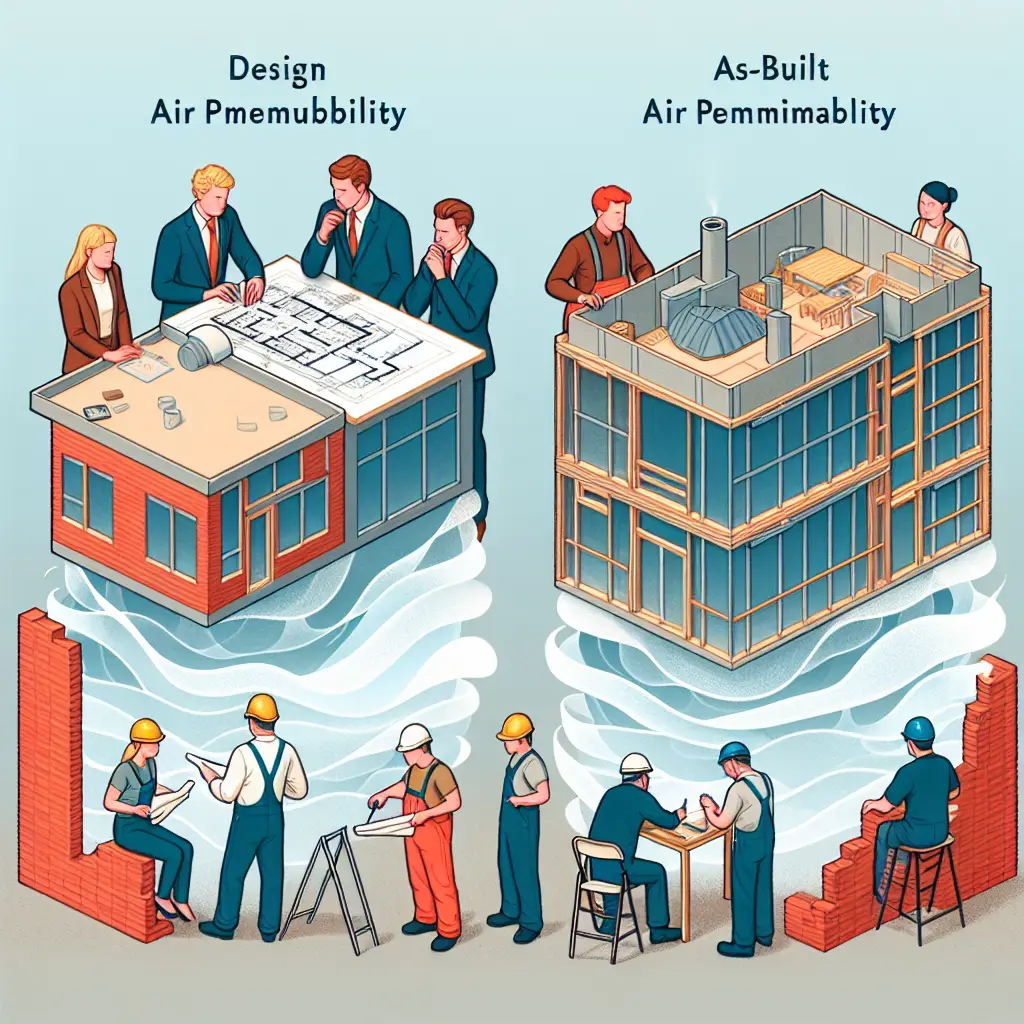Understanding the Difference Between Design Air Permeability and As-Built Air Permeability in Building Construction
In the realm of modern building construction and regulation, air permeability is a critical factor that influences energy efficiency, comfort, and indoor air quality. Both design air permeability and as-built air permeability play significant roles in ensuring that buildings adhere to the rigorous standards set out by building regulations. However, understanding the nuances between these two concepts is essential for architects, builders, and anyone involved in construction projects.
Effective air permeability management helps buildings achieve better thermal performance, resulting in reduced energy consumption, lower utility bills, and a more comfortable living environment. Let us delve deeper into these two facets of air permeability and explore their definitions, purposes, standards, and key differences.
Design Air Permeability
Definition and Overview
Design air permeability is the theoretical target value established during the planning and design phase of a building project. It represents the anticipated level of air tightness that the building’s envelope – the physical separator between the interior and exterior – is expected to achieve once construction is complete. This calculated value is integral to the design process as it guides key decisions and shapes the overall approach to energy efficiency and comfort within the building.
Purpose and Importance
- Design air permeability is fundamental in predicting a building’s energy efficiency. By aiming for specific air tightness levels, architects can develop strategies to minimize energy losses, reduce heating and cooling costs, and enhance the building’s environmental impact.
- This target serves as a benchmark for planning ventilation strategies. It helps architects select the right ventilation systems to maintain indoor air quality while ensuring that the building does not lose excessive energy.
- Compliance with building regulations is one of the primary considerations in setting design air permeability targets. For instance, Approved Document L Volume 1 in the UK outlines minimum standards for energy efficiency and air tightness, prompting architects to aim for a design air permeability of less than 5 m³/(h·m²) at 50 Pa for many projects.
Standards and Guidelines
Building regulation documents, like those mentioned above, pave the way for articulating the standards required for new constructions. These guidelines ensure that buildings attain a certain degree of air tightness, balancing energy efficiency with fresh air exchange. By adhering to these standards during the design phase, builders and architects can ensure future compliance and avoid costly modifications post-construction.
As-Built Air Permeability
Definition and Overview
As-built air permeability is the actual level of air tightness measured after a building has been constructed. In contrast to the design phase’s theoretical projections, this value is determined through practical testing, most commonly through a blower door test. This test quantifies the air leakage rate by depressurising the building and measuring the volume of air that enters through gaps in the envelope.
Purpose and Importance
- The primary aim of testing as-built air permeability is to verify if the finished building meets the design air permeability targets and legislative requirements.
- It serves as a metric for identifying unintended air leaks, and pinpointing areas that may necessitate remedial work to enhance air tightness and efficiency.
- Understanding as-built air permeability aids in refining energy efficiency and ventilation strategies. If measured values exceed limits, further work or adjustments may be required to diminish energy consumption and improve indoor comfort.
Standards and Testing Methods
The standards for as-built air permeability are stringent, often more so than those set during the design phase. For example, buildings in the UK might target an air permeability of less than 3 m³/(h·m²) at 50 Pa. A professional assessment and testing service, such as the one offered by Ratio Seven, ensures that these requirements are accurately measured and reported, allowing homeowners and builders to make informed decisions about their property’s air quality and energy performance.
Key Differences
Understanding the differences between design air permeability and as-built air permeability is crucial in aligning expectations with reality and ensuring compliance with regulatory frameworks. Here is a concise rundown of the main distinctions:
- Timing: Design air permeability is set during the initial design phase, while as-built air permeability is determined post-construction.
- Purpose: Design air permeability is a predictive, planned objective that guides the construction process to optimise energy efficiency and compliance. As-built air permeability serves as empirical validation, illustrating how well the construction has adhered to the design intentions.
- Measurement: Design air permeability represents a calculated value, relying on assumptions and projections. As-built air permeability results from empirical measurement, providing real-world performance data.
Practical Applications
Incorporating both design and as-built air permeability concepts in construction projects is not just a regulatory requirement but also a best practice for optimising building performance. By setting realistic design targets and rigorously measuring the as-built air tightness:
- Developers and Builders can minimise costly alterations and remedial work, ensuring a higher-quality end product.
- Homeowners and Occupants benefit from enhanced comfort, superior energy efficiency, and reduced costs on energy bills.
- Regulatory Bodies and Inspectors gain confidence that new constructions are sustainable, energy-efficient, and compliant with legal and environmental standards.
Frequency Asked Questions
Why is it important to differentiate between design and as-built air permeability?
Understanding the distinction is crucial for ensuring buildings meet legal and functional requirements for energy efficiency and ventilation. Design air permeability outlines goals during planning, helping inform the choice of materials and methods. As-built air permeability tests confirm that these plans have been accurately realised, highlighting any discrepancies that require attention.
What could cause disparities between design and as-built air permeability?
Disparities between design and as-built air permeability could arise from several factors, including construction errors, material inconsistencies, or inadequate sealing of building components. Design assumptions may not fully account for human error or on-site challenges, resulting in variances between expected and actual performance. Recognising these differences allows for targeted improvements and adjustments.
How do builders ensure compliance with both design and as-built air permeability standards?
Builders ensure compliance by integrating robust design practices with high-quality construction methods. During the design phase, meticulous attention to detail and accurate modelling lay the groundwork. During construction, rigorous quality control, skilled workmanship, and timely testing practices – such as blower door tests – ensure as-built performance aligns closely with design expectations. Collaboration with specialists, like those at Ratio Seven, can assist in maintaining compliance and consistency.
Importance of Professional Collaboration
Navigating the intricate landscape of air permeability testing and regulation is a task best carried out by experts. Companies like Ratio Seven offer comprehensive services to manage and measure both design and as-built air permeability, bridging the gap between theoretical plans and practical outcomes. Their expertise ensures adherence to standards, optimising the building’s performance for the benefit of developers, occupants, and the environment alike.
Whether you are embarking on a new building project or refining an existing one, engaging professional services not only meets mandatory requirements but also adds value to your construction efforts through improved energy efficiency, a reduced carbon footprint, and enhanced indoor environments.
In sum, the articulation between design air permeability and as-built air permeability reflects a synergy of planning, execution, and validation. By effectively managing both, all stakeholders contribute to more sustainable and energy-efficient building environments.




